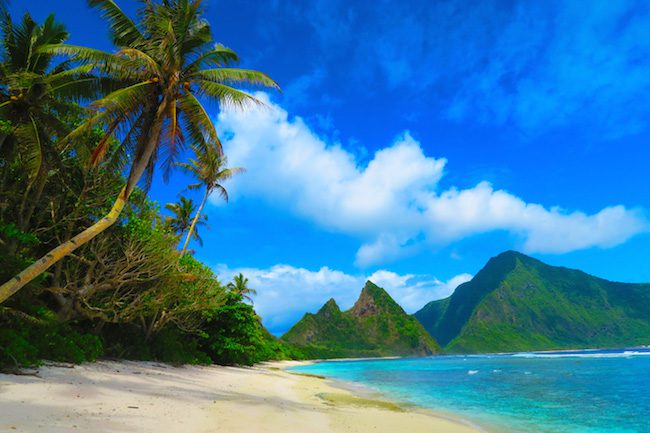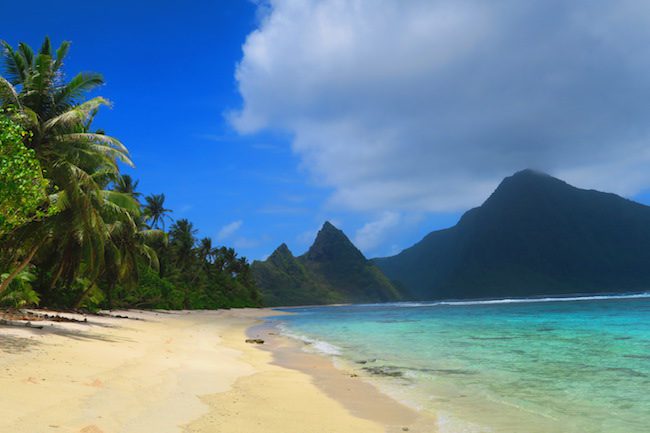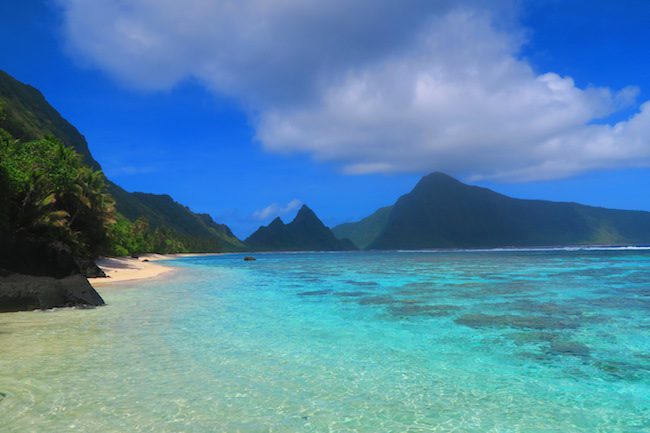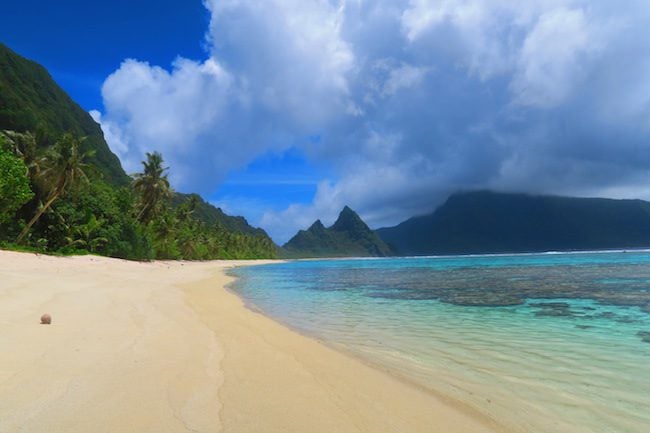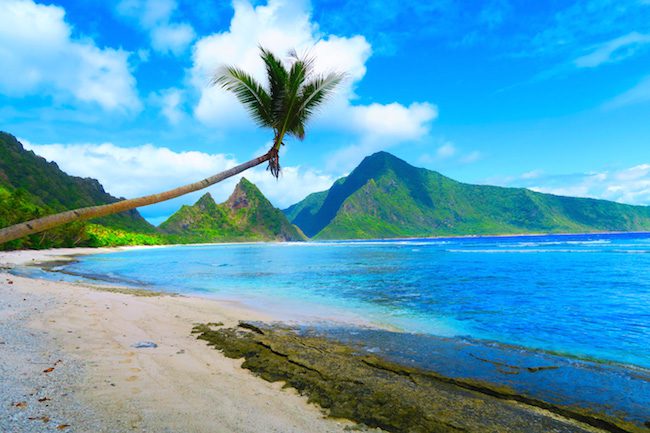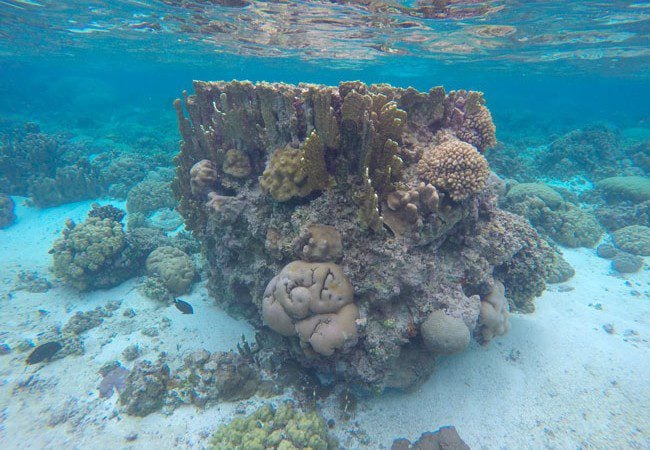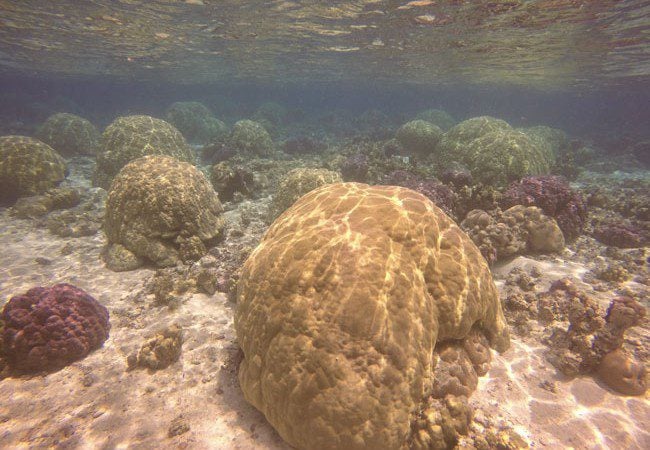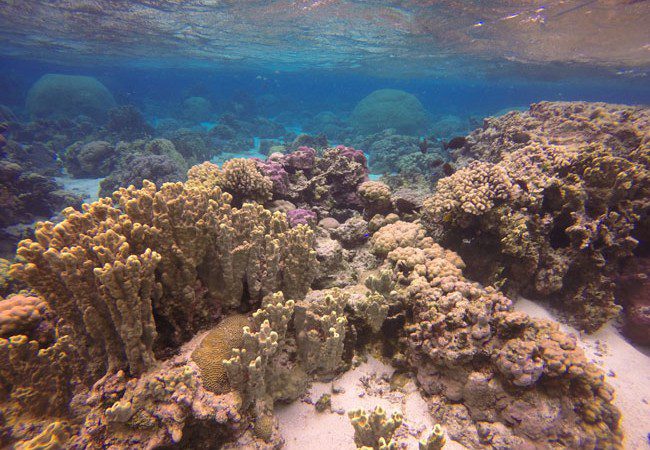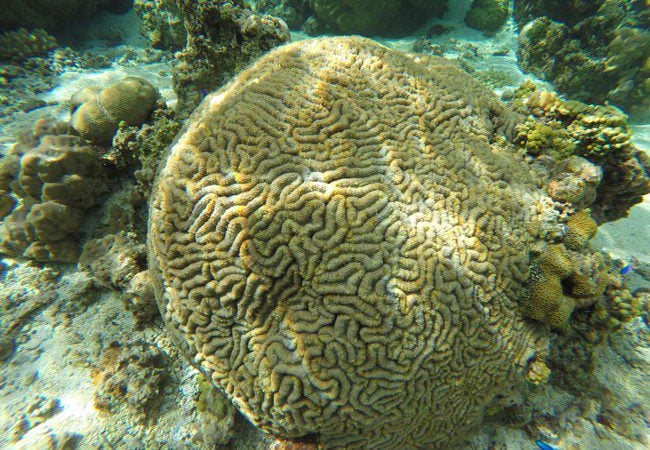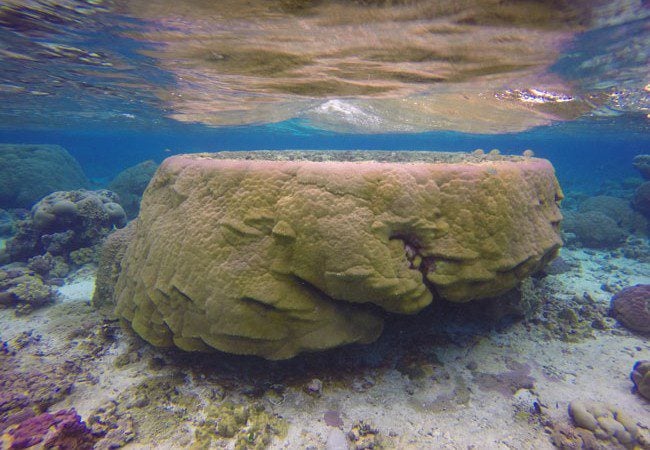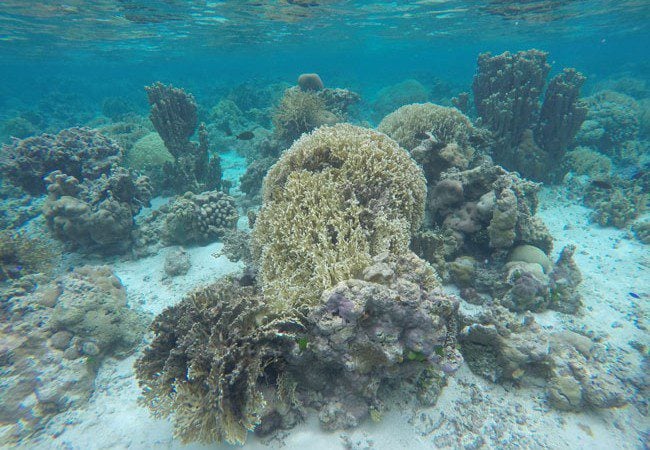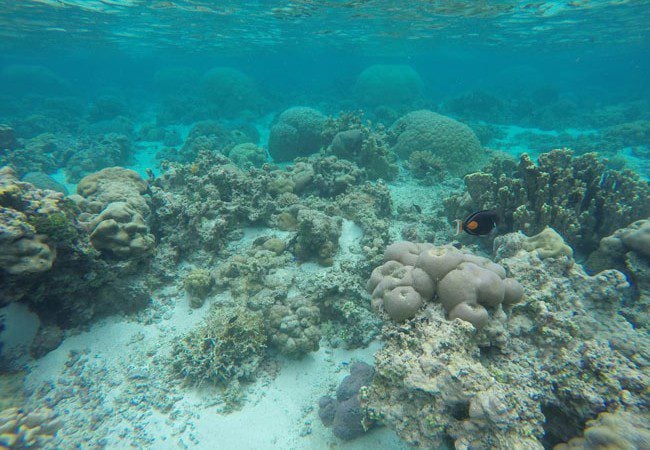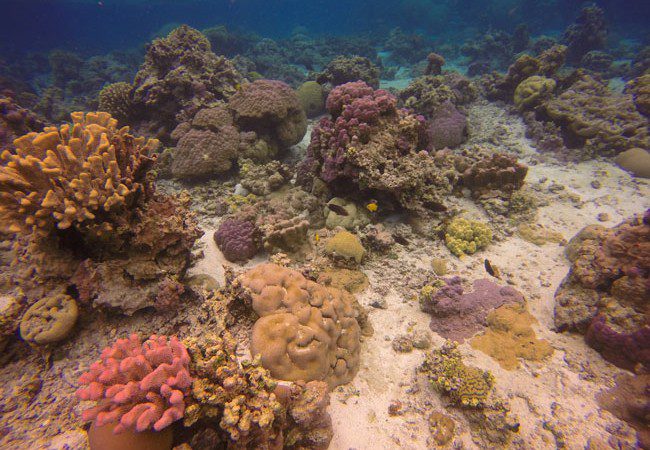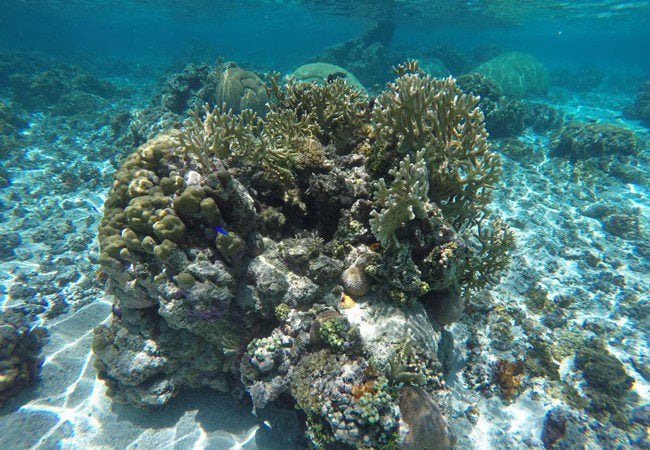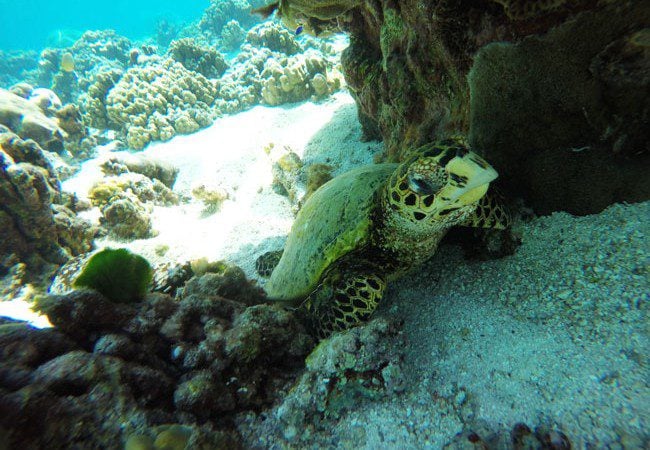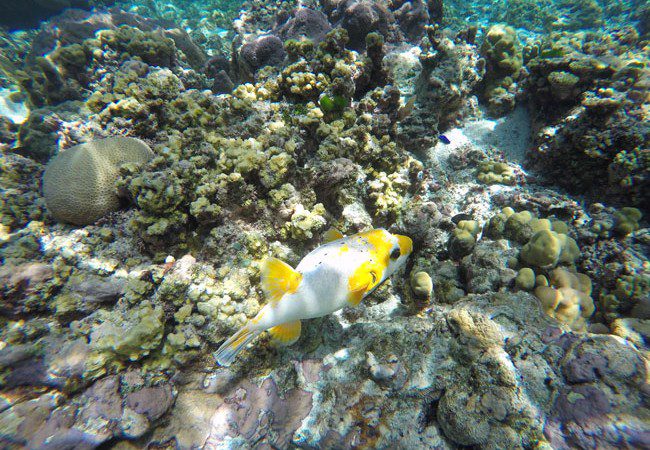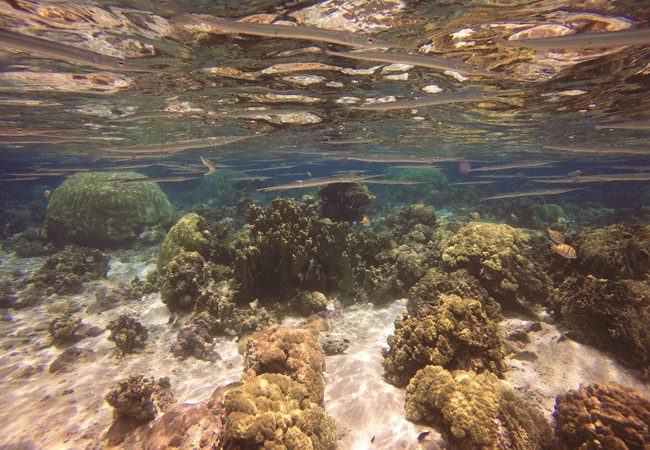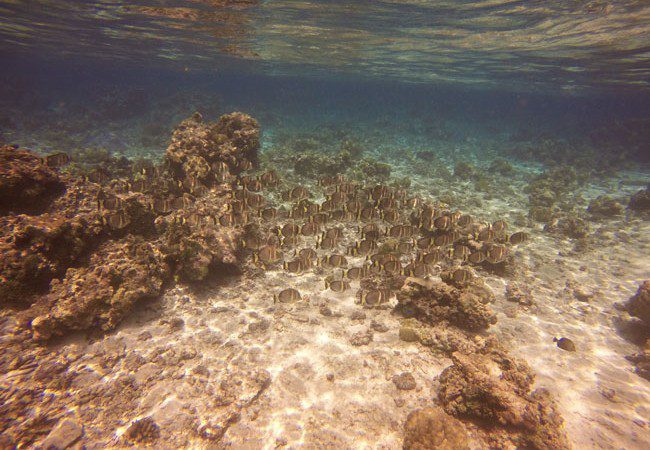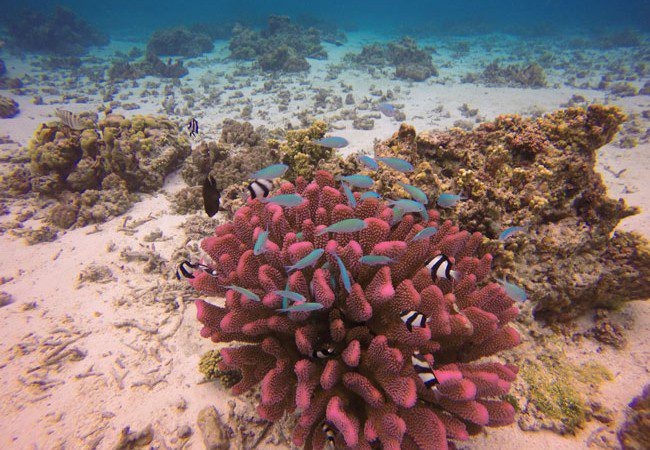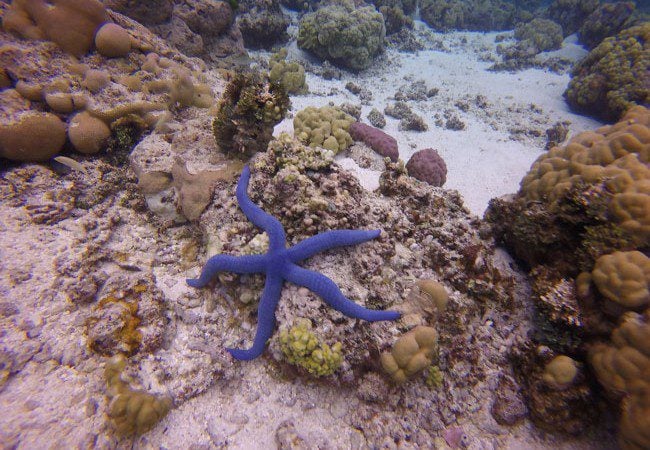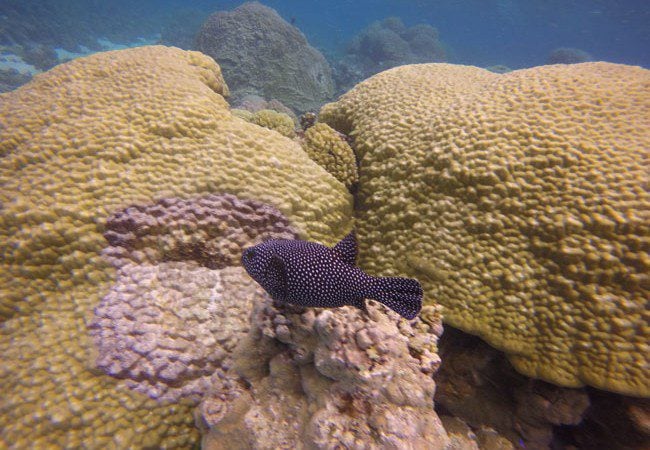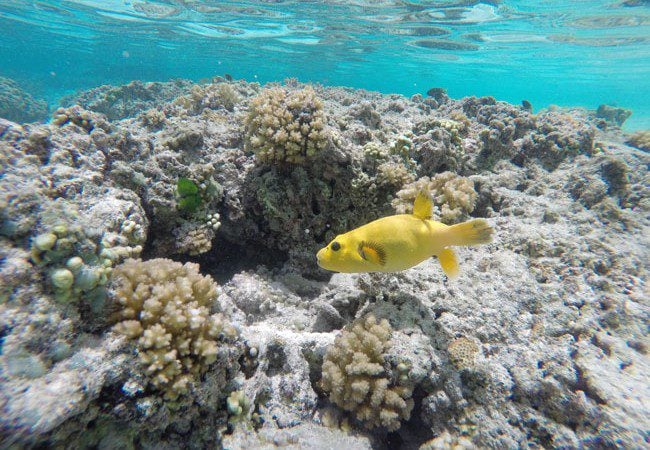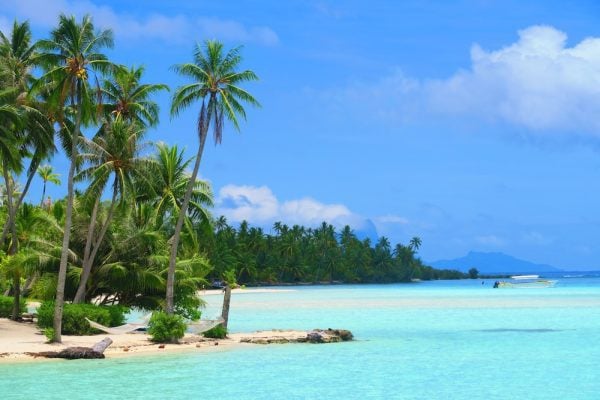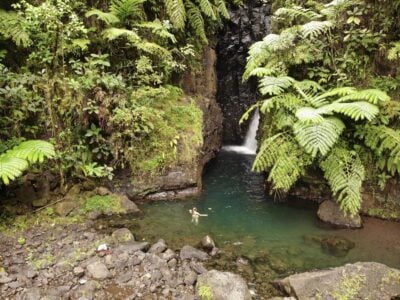10 Days In American Samoa
Part 2: The Manu’a Islands – Ofu & Olosega (7 Days)
A travel cliché says that the toughest places to reach are often the most rewarding. This is true of the twin islands of Ofu and Olosega in the Manu’a Islands of American Samoa, among the most remote tropical islands that can ‘relatively’ easily be reached.
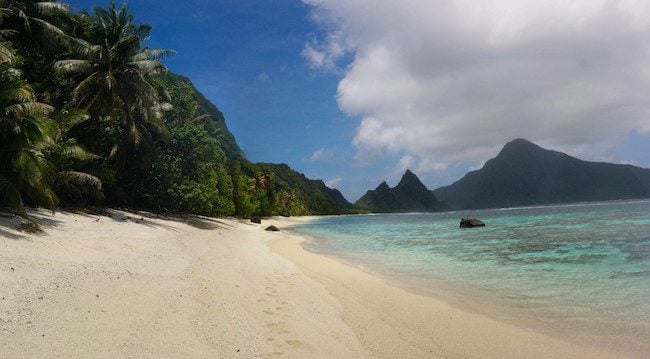
Touchdown on the beachside runway in Ofu signals the start of the weekly rush hour, as locals greet relatives returning from Tutuila with a big smile, government workers change shifts and a few lucky tourists begin the vacation of a lifetime. On the menu? Jungle-covered peaks hiding rare coconut crabs under the canopy, some of the cleanest air in the South Pacific, sleepy villages waking up only for Sunday church service, and a beach worthy of an Oscar – if only ‘The Academy’ would be aware of its existence.
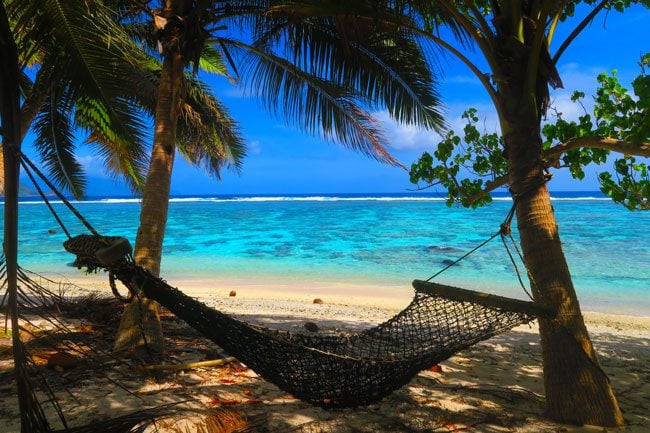
Any traveler in search of a pristine, yet-to-be-discovered destination and with a love for the tropical outdoors – should absolutely make the effort to make it to Ofu. After All… you’ve come this far. The only catch? Once you’ve visited paradise, how will everything else compare?!
- Flying is your only (practical) way to get to Ofu. At the time of writing this guide, Polynesian Airlines (rebranded as Samoa Airways) was the only airline serving the Manu’a Islands, with a weekly direct flight to Ofu from Pago Pago (30-40 mins), therefore making sense to spend an entire week in paradise.
- You can fly to/from neighboring Ta’u, more frequently serviced by direct flights from Pago Pago by Samoa Airways. However, you will need to arrange a boat transfer to Ofu which costs about $150 per boat (and can be choppy). Your host will help you arrange this and the more passengers to share the ride, the cheaper it is per person.
- One thing to note: the FAA keeps a tight lid on small airlines servicing the islands. It, therefore, renews the airline’s license on a monthly basis, which means securing your Ofu flight can only be done within the month you wish to travel. Paradise is hard to reach but trust me, it’s totally worth it.
- In Pago Pago, get to the airport at least 2 hours prior to your flight. If the check-in counters are not yet manned, leave your bags by the counter to mark your spot. Planes are very small and tend to reach their weight capacity quickly, with ‘heavy’ locals flying to/from the islands along with cargo which often includes coolers packed with fresh fish. To avoid the near heart attack I had, it’s better to get to the airport early!
- There are no ATM’s on Ofu and Olosega so bring all the cash you need. Each village does have at least one small grocery shop but if you have some extra weight in your bag, pick up some snacks in Pago Pago for the week.
- There is no cell phone reception in Ofu but there is surprisingly very fast internet. Do yourself a favor and use this week in paradise to do a digital detox.
- Avoid swimming near the small break in the reef on Ofu Beach as you can get sucked out to the open ocean (and nobody is around to save you). Look for the warning sign on the beach and inquire with your hosts. In any case, it’s located in a spot that’s not great for swimming so you’ll likely not make it out here.
- Aside from enough cash and some snacks, pack with you: hiking gear (long hiking pants), mosquito repellent, sandals/reef shoes, ‘nice’ clothes if planning to attend Sunday service (recommended) and plenty of books. When going hiking, take at least 2L of water per person with you.

(1) as of June 2017, Manu’a Airways is planning service from Pago Pago to Ofu (and from Pago Pago to Ta’u) starting in mid-2017. I don’t know if they’ll actually make this date or how long they’ll be in business but this is very good news for both locals and tourists trying to get to Ofu. (2) As of November 2017, Polynesian Airlines has been rebranded as Samoa Airways which also flies international routes from Samoa to/from Australia and New Zealand. Samoa Airways has announced bi-weekly flights from Pago Pago to Ofu in early 2019, but things constantly change when it comes to South Pacific aviation. (3) In October 2020, it was reported that newly formed Talofa Airways, which flies internationally between Samoa, American Samoa and Tonga, will enter the domestic market in AmSam with flights between Pago Pago and either Ta’u or Ofu. (4) as of November 2018, Samoa Airways can now book flights up to six months ahead, thanks to a special waiver granted by the federal government. Hopefully, this waiver will be extended but keep in mind that things can quickly change under certain circumstances.
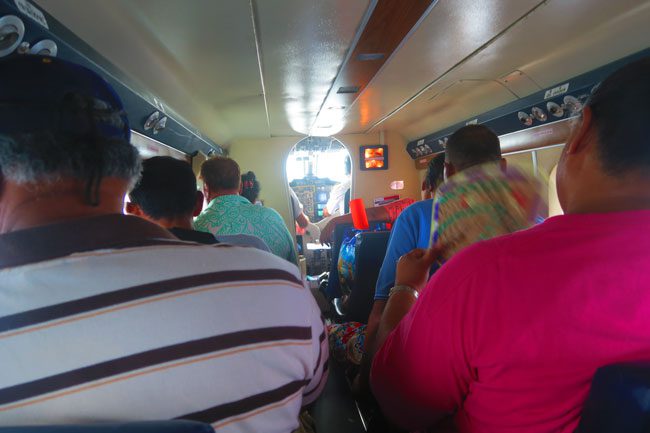
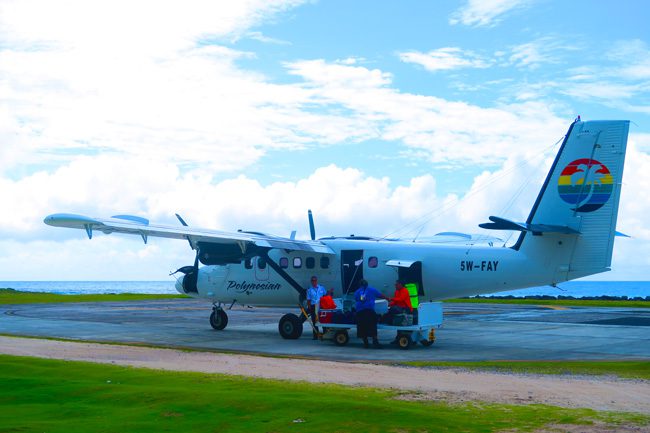
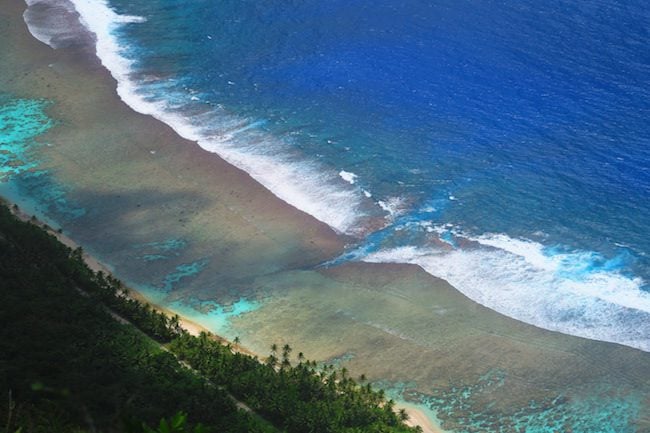
Where To Stay In Ofu?
Without a doubt, the best place to stay in Ofu is at the Vaoto Lodge. A long-running family establishment since 1979, it is now run to perfection by Deb and Ben. Deb is the daughter of the lodge’s founders and Ben is the descendant of a Japanese family whose Pago Pago shop was ironically the only one damaged in the sole Japanese shelling of Pago Pago in WWII. Considering just how remote this place is, the lodge exemplifies the true meaning of paradise – without the need for luxury overwater bungalows.
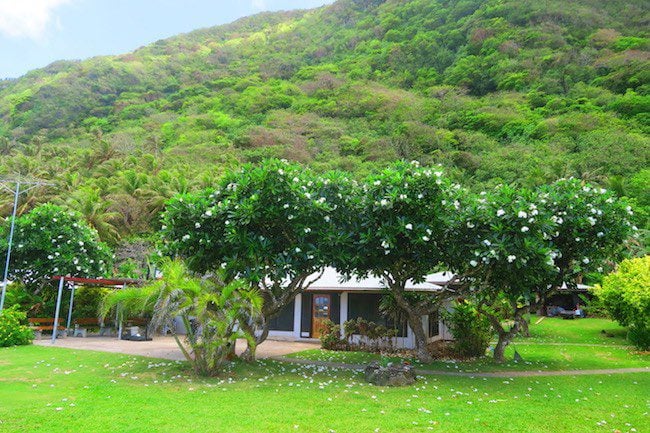
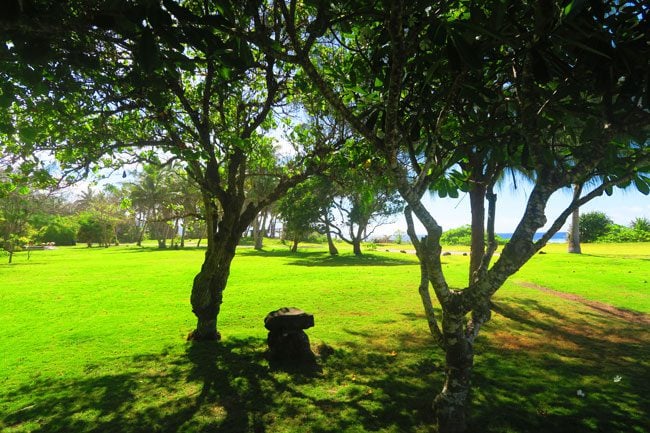
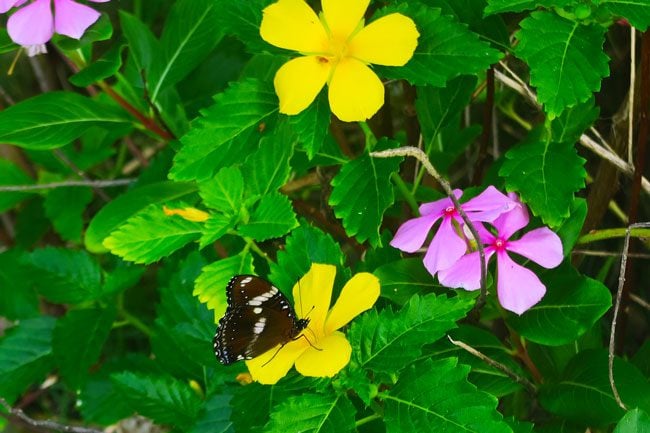
The lodge is located on a green patch of grass dotted with heavenly scented trees right at the very edge of the airstrip. The most ‘happening’ spot on the island when the weekly flight lands and departs, the airstrip is unused during the rest of the week – a fantastic spot for stargazing.
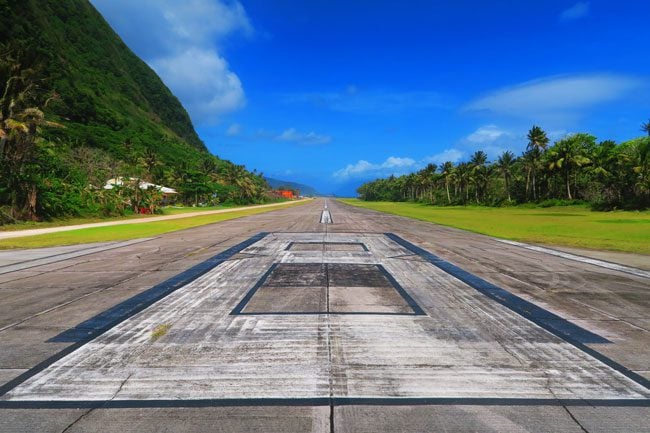
Rooms are large, clean and comfortable, complete with mosquito nets, a hot shower, fan, and some even with wall-mounted AC units. Windows are screened and towels are provided.
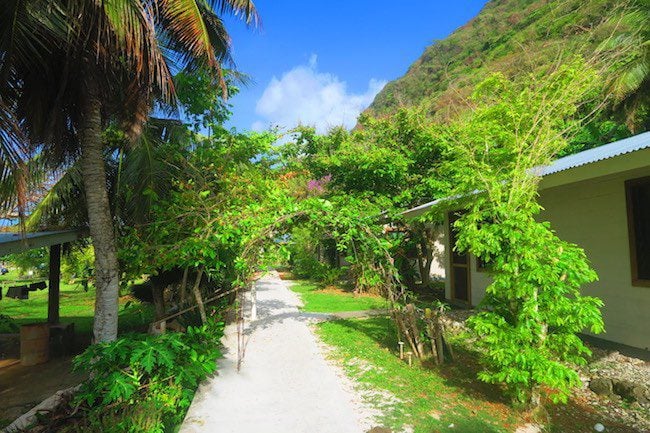
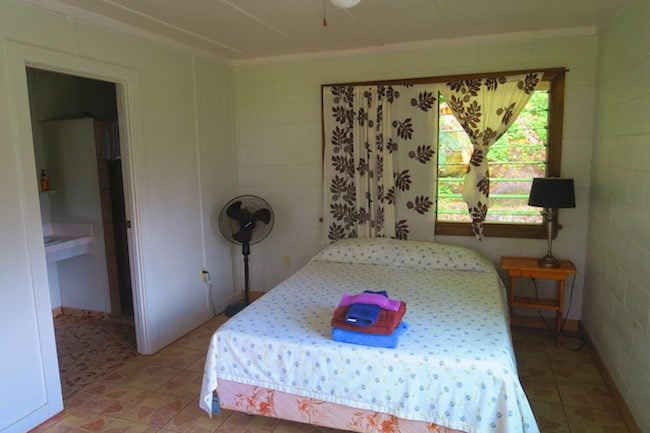
Meals and beer can be purchased, with the communal dinners the absolute highlight. Deb and Ben whip up delicious meals like Ben’s famous chili, seafood BBQ night, Mexican nights and home-baked pizza. The lodge often hosts marine biologists, journalists, researchers, visiting medical staff, missionaries and obviously – like-minded travelers like you, so the conversation is always fascinating. Cold drinking water is free to use and the main house is where you’ll get online (surprisingly fast wifi), shoot some pool, grab a book or watch TV.
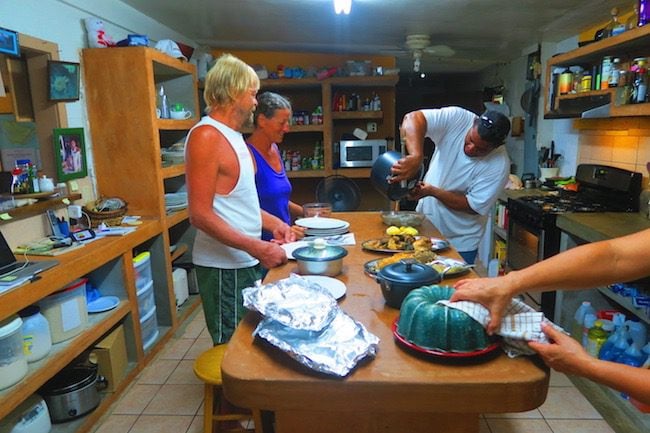
The lodge does have some snorkeling equipment left over by other guests but I highly recommend bringing your own (fins useful but not a must). There were no bicycles to use when I visited but you might be able to rent a vehicle if one is available. Getting around on foot is not a problem though and any local passing by will always offer a lift.
Ofu Beach is a pleasant 15-20 minute walk from the lodge, but there is a beach right out front that’s good for swimming and snorkeling between the tides. In season, you’ll even be able to spot whales off the coast. The National Park’s ranger station is adjacent to the lodge, a convenient stop upon arrival for learning about the superb hiking opportunities on the islands.
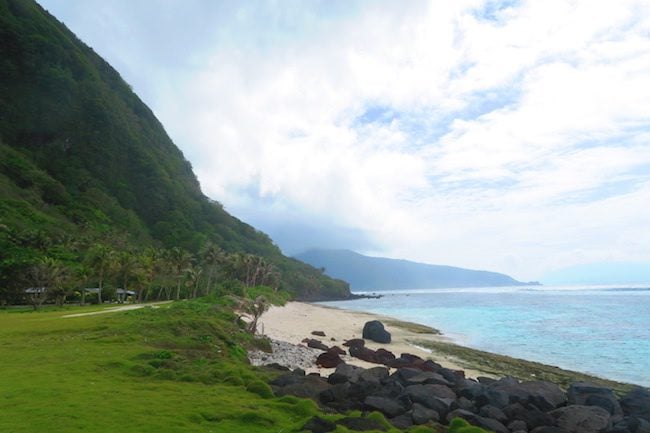
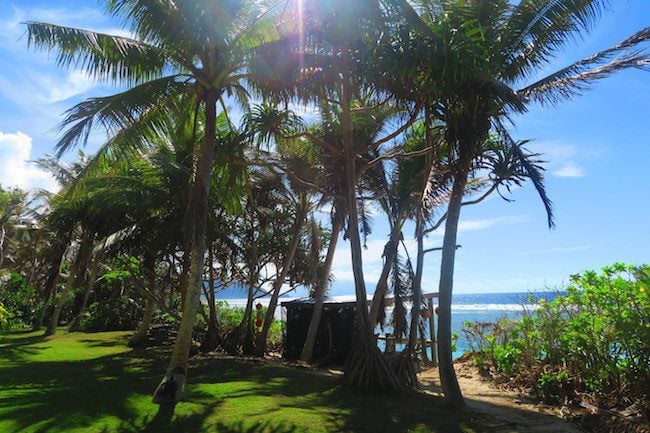
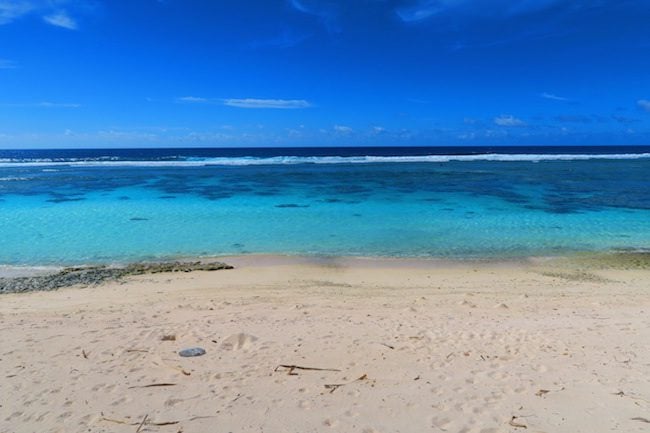
In the event that Vaoto Lodge is fully booked, the Asaga Inn is also a comfortable option. The inn is operated by Army veteran Trevor and his family, descendants of the chief responsible for successfully lobbying the American government to build a bridge over the Asaga Strait, finally connecting Ofu with Olosega. You’ll find here comfortable air-conditioned rooms, wooden outdoor fales (Samoan open-air huts) and a grocery shop. The inn is located on the western side of the bridge, about a 20-minute walk from the prime swimming area of Ofu Beach. Should the Asaga Inn be full, there is a colorful grocery shop owner in Olosega Village that also offers rooms for rent. You’ll need to ask around about this option but that shouldn’t be a problem as everybody knows each other over here.
Things To Do In Ofu & Olosega
Since you’re here for a week and the islands are so small, there’s not really a good and bad way to arrange your time. So I’ll simply list all the top things to see and do in this section and you can plan your own itinerary.
The Coastal Road
A concrete road connects the villages of Ofu with Olosega. Well, to be exact, the road ends a few hundred meters before each village and the rest of the way is just sand. With power lines buried in the ground to protect from the elements, walking along the road feels like walking on some distant tropical planet. On one side, the strikingly blue and white colors of water and sand peak from time to time from beyond the thick coastal vegetation. On the other side, thousands of coconut trees grow in the footsteps of Mount Tumutumu, teeming with flying fruit bats and songbirds galore. In front of you are the signature jagged edges of the Sunu’itao Peak. It really doesn’t get any better than this, and you’ll be whistling from pure happiness all the way. The only road hazard? The occasional falling coconut!
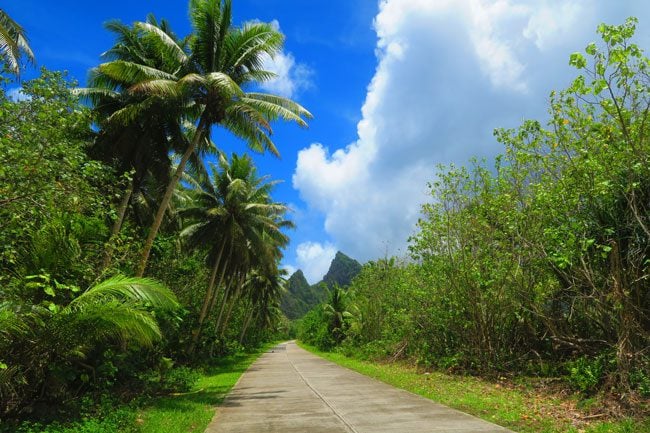
Ofu Beach
It’s hard to describe the sense of accomplishment upon touching down on Ofu Beach, which has to be one of the prettiest tropical beaches in the world without a doubt. The soft white sand simply melts between your toes, the leaning palm trees perfectly bend to isolate you from the rest of the world, the mountains in front of you rise like giant shark fins out of the water, and the water – oh the water! And you know what the kicker is: you’ll have this long stretch of pristine beach all to yourself. Here’s what it looks and sounds like on Ofu Beach.
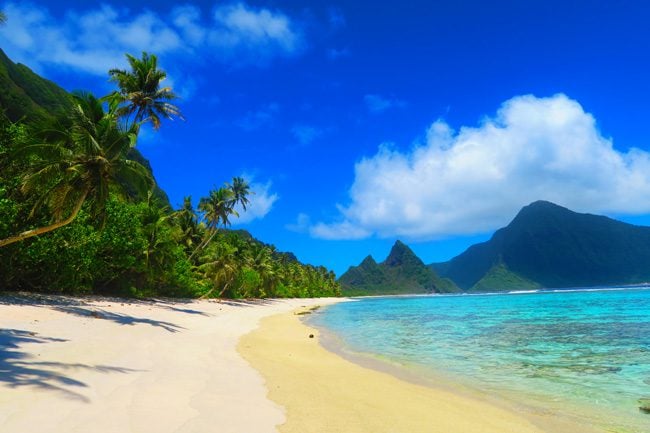
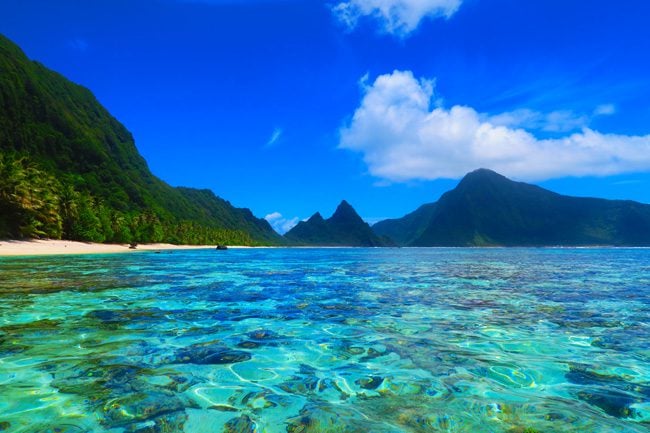
Aside from the occasional local’s BBQ over the weekend, I hardly saw anyone on the beach during my week in Ofu. After walking up and down the beach several times and testing out various spots, I came to the conclusion that the best spot is right across the hurricane shelter. You’ll see this shack on the side of the road so simply cross over to the beach, where makeshift chairs and tables mark the spot.
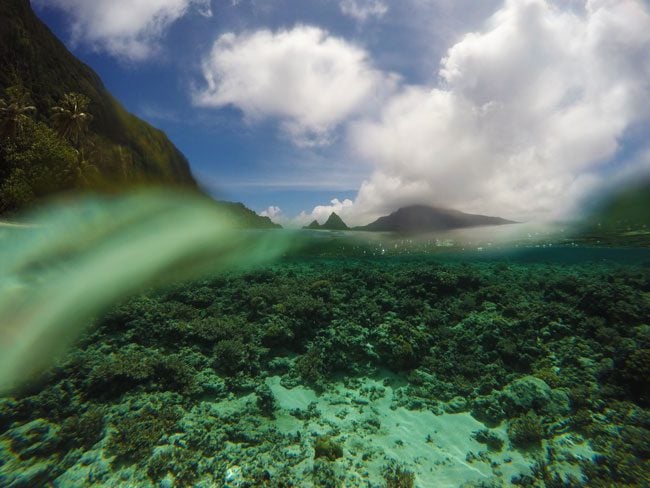
Here’s an interesting anecdote for you. Did you know that as a parrotfish consumes fish and algae from the coral reef, it ‘poops’ out the undigested coral in the form of pure white sand? A single parrotfish can produce 1 ton of sand every year! With so many of these guys around, it’s no wonder why the sand on Ofu Beach is of the purest kind.
Since I am terribly bad at selecting just one photo and Ofu beach is the prettiest I’ve ever been to, here’s a slideshow with additional images from paradise!
Swimming & Snorkeling
The coral reef and lagoon in Ofu Beach is among the healthiest marine ecosystems in the South Pacific. Scientists from around the world come all the way out here to study the unexplained ability of Ofu’s reef to quickly recover from coral bleaching. The reef and beach are protected as part of the National Park of American Samoa.
The first time I ventured underwater with a mask, I remember feeling a profound sense of ‘wow’. The water is incredibly clear and just meters from the beach are corals in all shapes and sizes, both hard and soft. Especially impressive is the giant boulder and mushroom coral, where turtles like to nap at their base and where small fish like to gather at their soup bowl-like top.
In the fish department, you’ll often find yourself completely surrounded by schools of Dartfish, always returning to formation when interrupted. Colorful groupers, pufferfish, trumpet fish and even reef sharks (if you’re lucky) are just some of the friends you’ll have in the absence of human companions back on dry land. But be warned, these friends are quite shy, perhaps because they don’t get too many visitors around here.
The best time for swimming and snorkeling in Ofu Beach is between the tides. In high tide, there is too much sand that gets tossed around by the waves but even at low tide, you’ll find a few shallow pools deep enough for swimming but not deep enough from moving from one pool to the other.
Here’s a video that summarizes the underwater highlights from Ofu Beach!
Ofu Village
The sandy and sleepy Ofu Village is absolutely charming. It’s got a couple of churches, three small shops, and a pretty little beach. The small Nu’utele Island lies just off its coast, though I was told by locals that getting there might seem easy but in fact it’s dangerous and parts of it are scared private land. Feel free to walk around but stick to the main road. Every home has at least two dogs so it’s advised to carry a small branch or a rock to scare them away should they come and check you out.
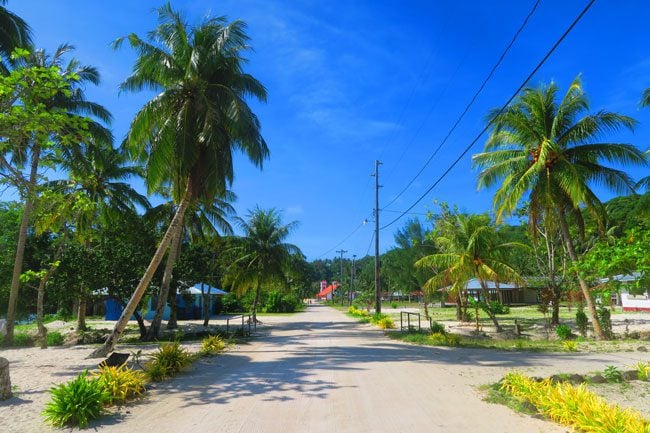
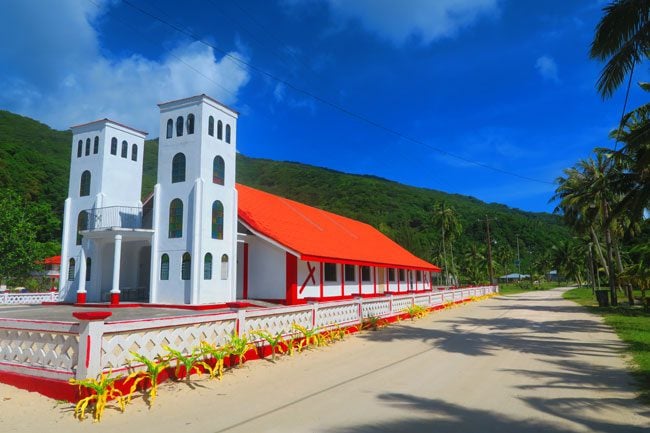
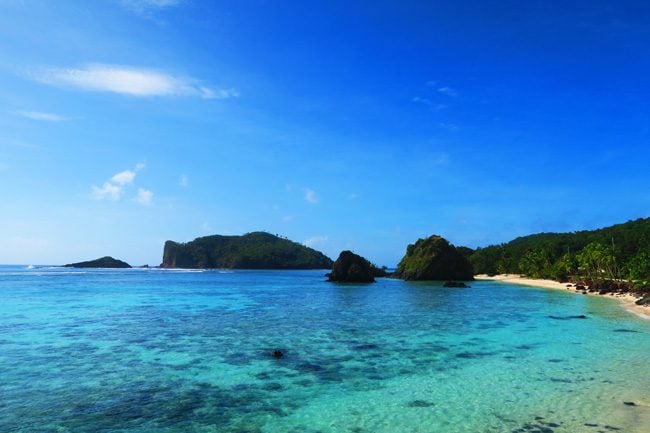
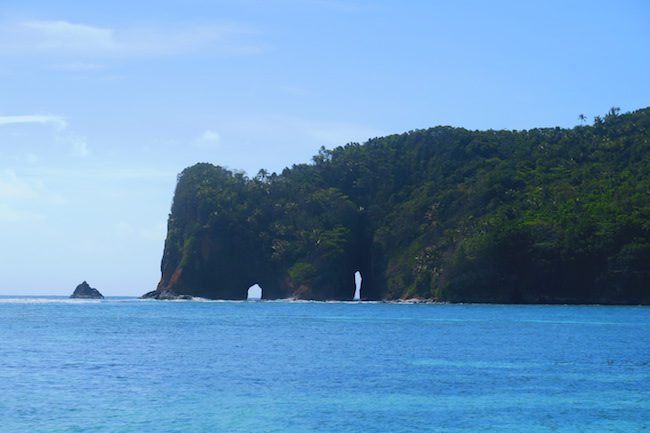
The best time to visit Ofu Village is on Sunday. Though it’s the Catholic church that gets top marks for exterior looks, it’s what’s inside that counts, right? I heard a rumor that the folks at the tiny Pentecostal church sing the loudest. Ben from Vaoto Lodge graciously gave me a lift for a Sunday morning that I will never forget. From the outside, the church looks like an ordinary house, that is until you get a bit closer…
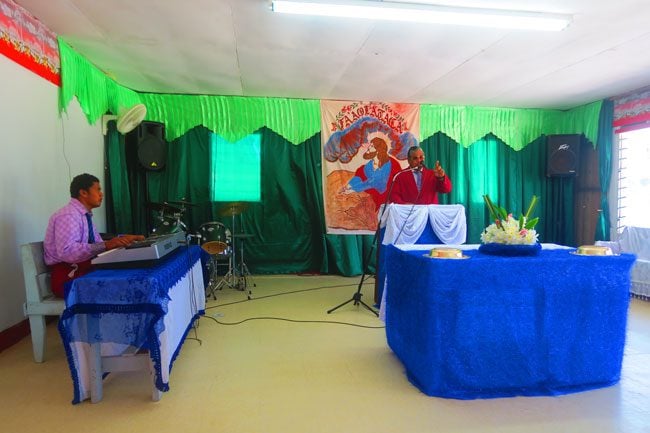
Inside, members of the church whom you can count with 10 fingers were paying close attention to the Sunday sermon delivered in Samoan by the charismatic pastor, who occasionally paused to squeeze in yet another quick ‘praise the Lord’. Before inviting me for dinner, his daughter sat next to me to translate her father’s words to English and then walked to ‘center stage’ to join her brother playing the keyboard, her other brother on the drums, and her mom on the mic for a memorable version of ‘Shake Your Body to the Lord’. Give it a listen for yourself!
Tumu Mountain Hike
The challenging hike up to the highest point on Ofu Island (494 meters) is one of the most rewarding hikes you’ll ever embark on. It all starts from the marked trailhead just after the Ofu harbor (a 45-minute walk from Vaoto Lodge). The trail is clearly visible as it also serves as a 4X4 road up to the radio tower at the summit, though often covered with waist-high vegetation.
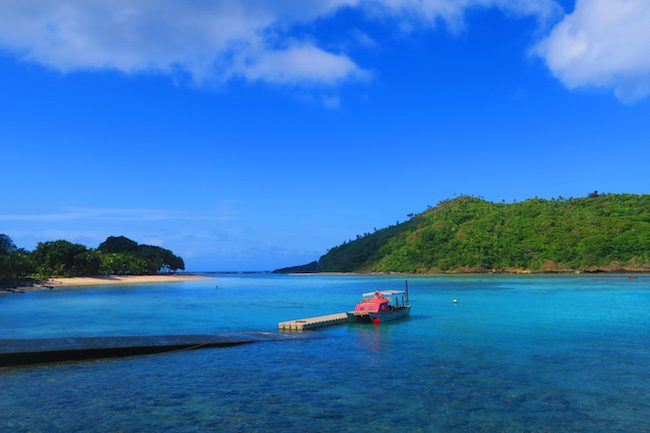
As you ascend, you’ll be treated to awesome views of the coastline and the tropical vegetation, to the orchestra of songbirds busy at work. From up here, you can see Sili Village, the third village in Ofu and Olosega though not really a proper village since there’s just one family living down there.
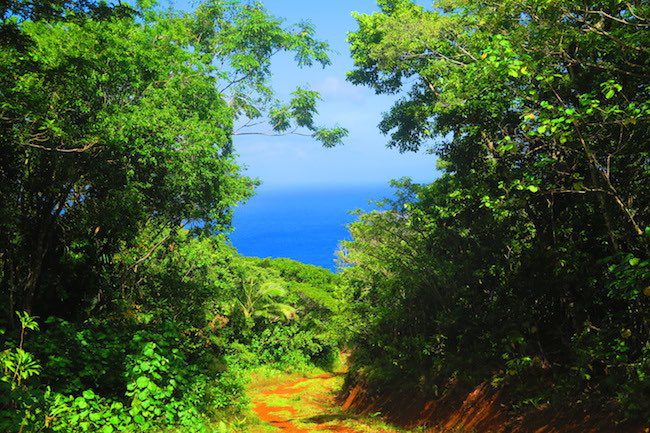
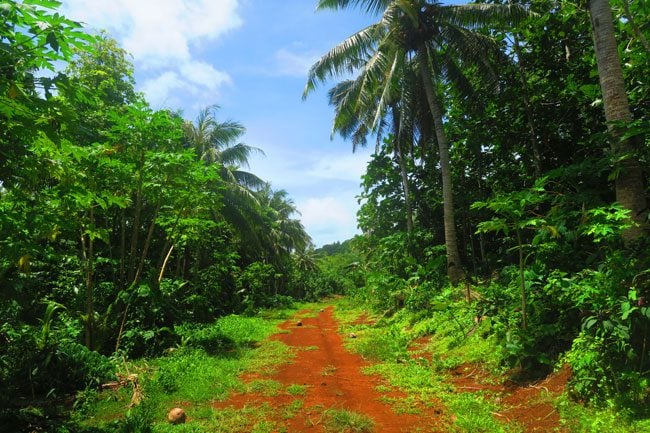
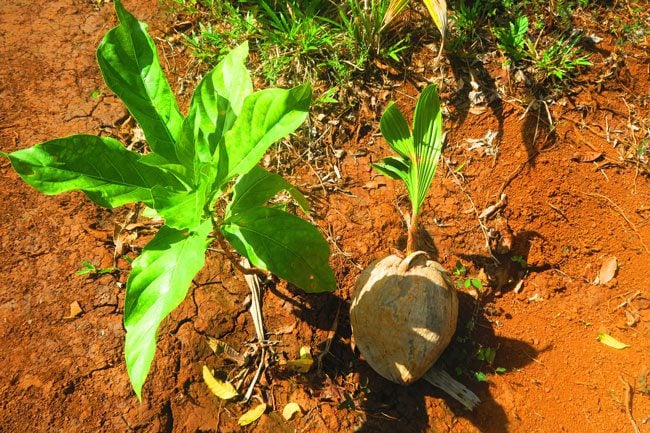
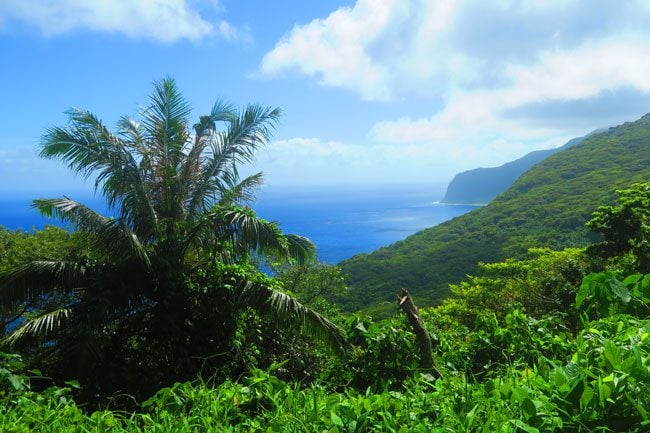
The trail then enters the rainforest, where it’s nothing but trees, tall grass, and geckos. If you’re lucky, you might spot flying fox bats or giant coconut crabs. These crabs used to be all over the South Pacific Islands, but apparently, they just taste so damn good that there are hardly any left on populated islands. The crab lives inland, hoisting fallen coconuts up high to the trees only to drop them with the hopes that gravity will crack them open.
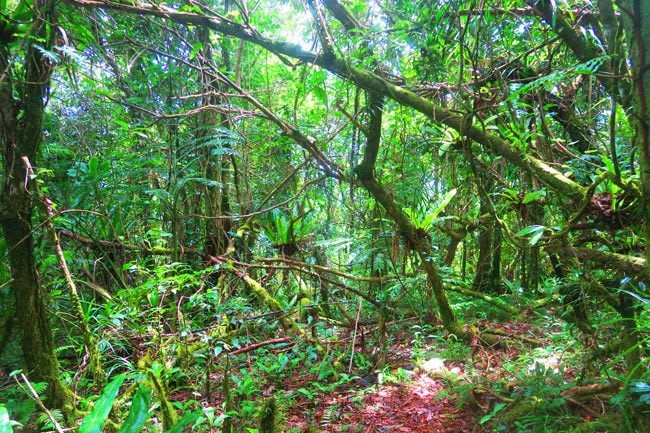
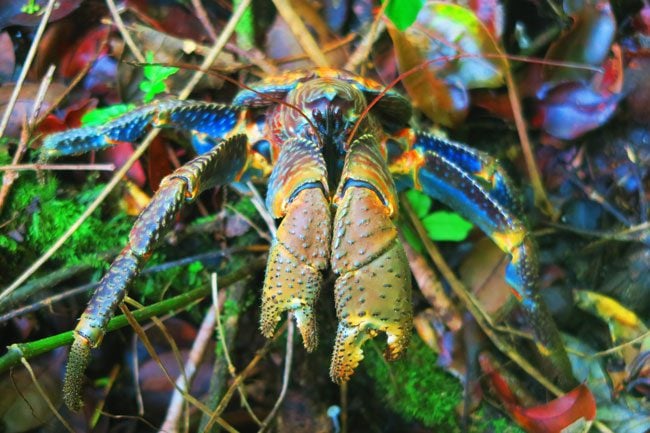
You’ll then reach the radio cover, where a small solar power station is in the works. Follow the small sign to the Tumu Overlook and follow the path through the thick vegetation until you’ve reached a set of massive boulders and a rope. There’s only one way from here and it’s up to the top.
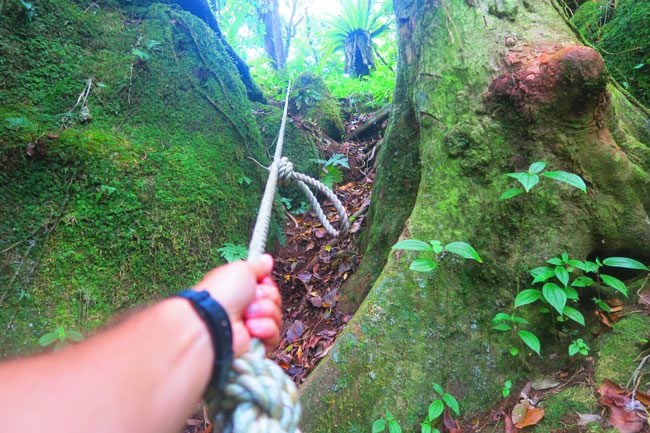
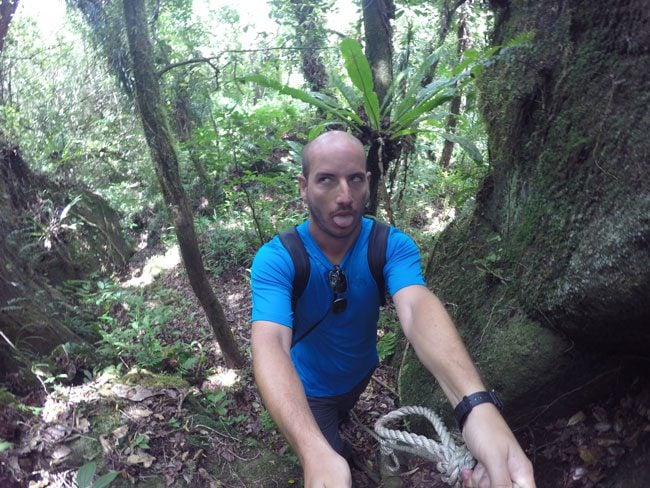
The Tumu Overlook is more like a balcony with a view to heaven! On a clear day, you can even see Ta’u Island in the distance. Here’s what it looked like at the top of Tumu Mountain!
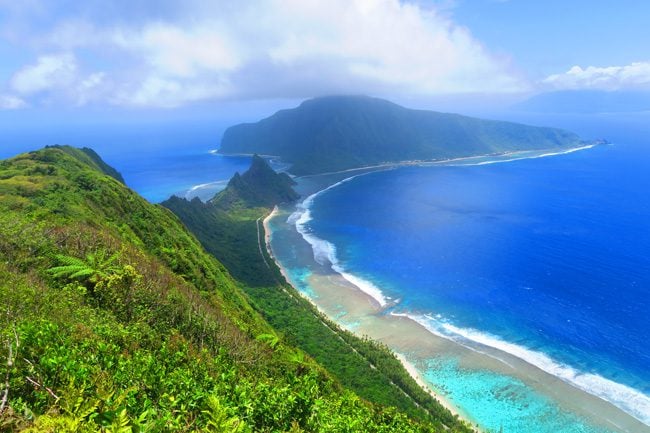
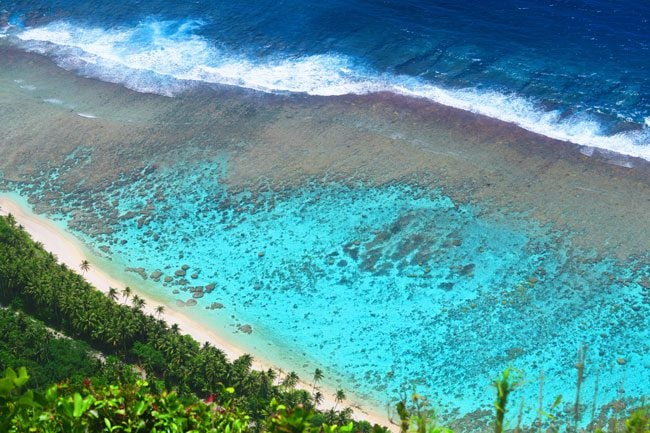
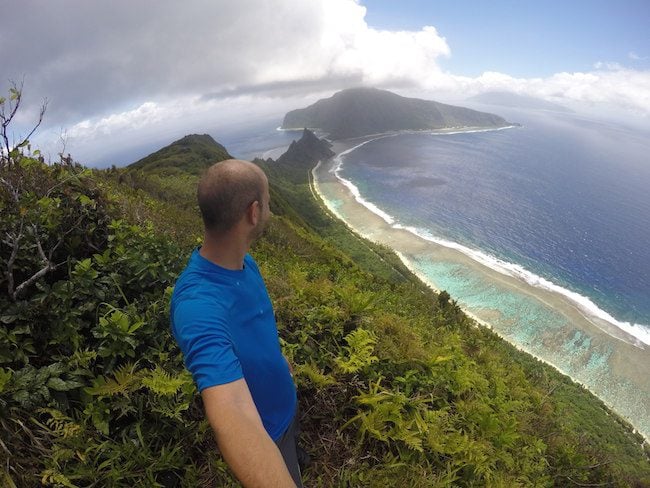
Logistics: the entire hike will take about 4-5 hours but be prepared to spend at least an hour at the overlook. Wear hiking shoes, a hat, long pants, and be prepared to be completely soaked in sweat. Pack at least 2L of water and snacks. Deb from Vaoto Lodge had a great idea of freezing small water bottles that would be better than a beer at the summit! I recommend attempting the hike on the first clear day you get and early in the morning.
Tuiofu Well & Tomb
This archeological site offers a chance to see early signs of life on this remote island. It’s nothing too impressive but it’s not too far from Ofu Beach. The site is located on private land so just check with the park ranger before visiting.
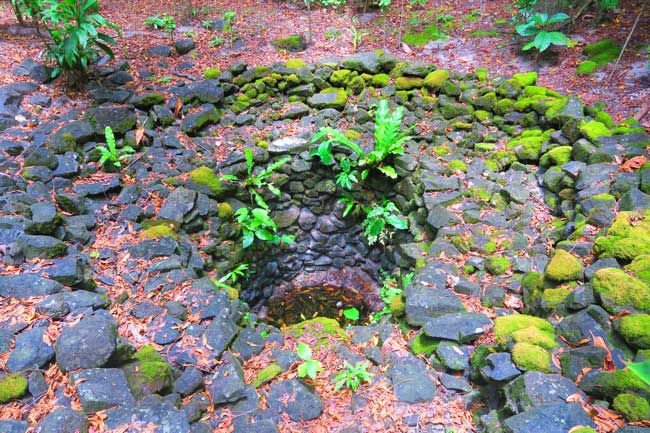
Asaga Strait
The body of water separating Ofu and Olosega had to be crossed by a 1-minute boat trip before a cyclone-proof bridge was built in 1979. These days, jumping off the bridge is as close to Disneyland as it gets on the islands, though it’s best to first check with the folks at the Asaga Inn if your timing is right.
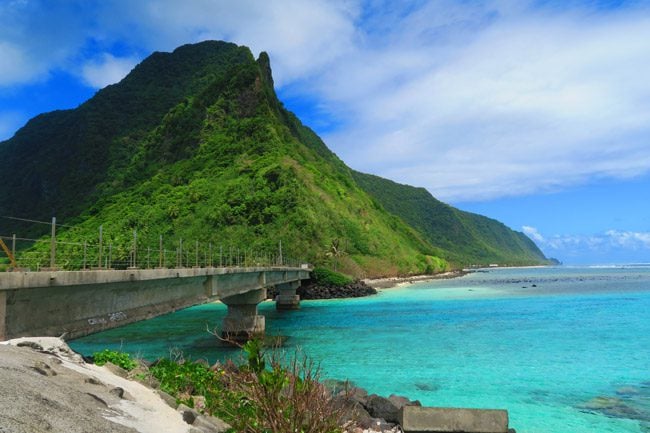
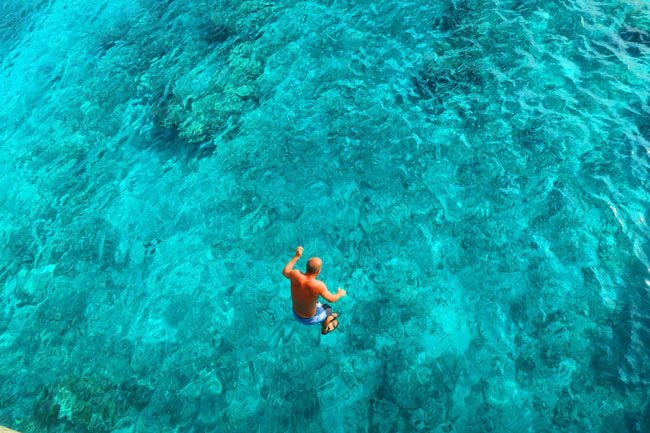
Olosega Village
Olosega is slightly more ‘happening’ than Ofu Village, maybe it’s because the school is located here. There’s a small shop in the center of the village and its beach is good for swimming.
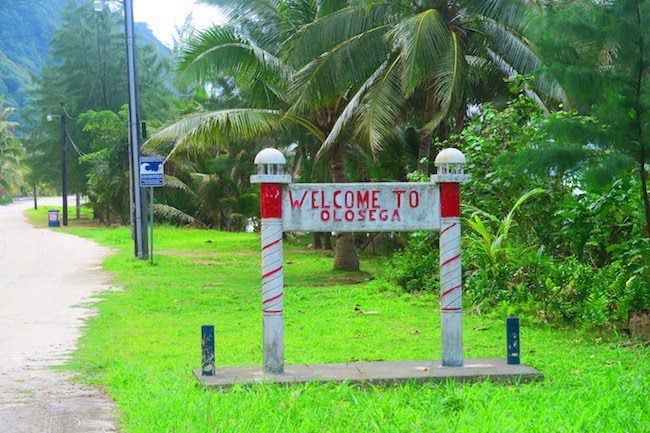
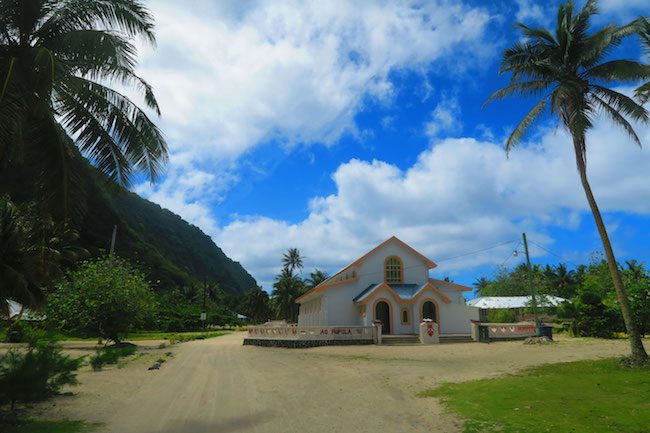

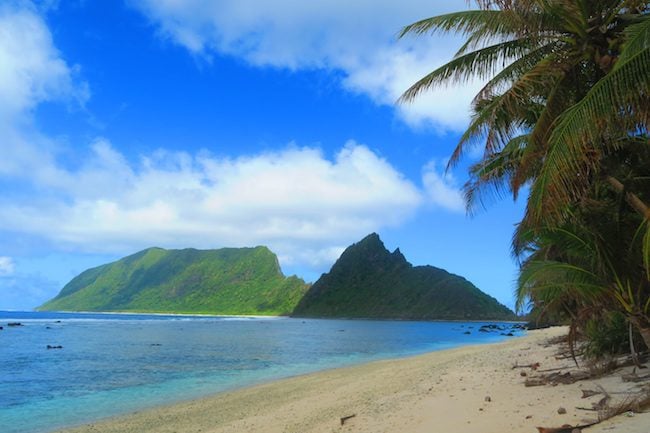
Oge Beach Hike
The second trail is maintained by the National Park of American Samoa, you’ll find the marked trailhead just after the landfill at the very edge of Olosega. The trailhead offers a different vantage point back towards the Sunu’itao Peak, Tumu Mountain, and Ofu Beach. You’re now right at the footsteps of Mount Piumafua, the highest point on Olosega (639m).
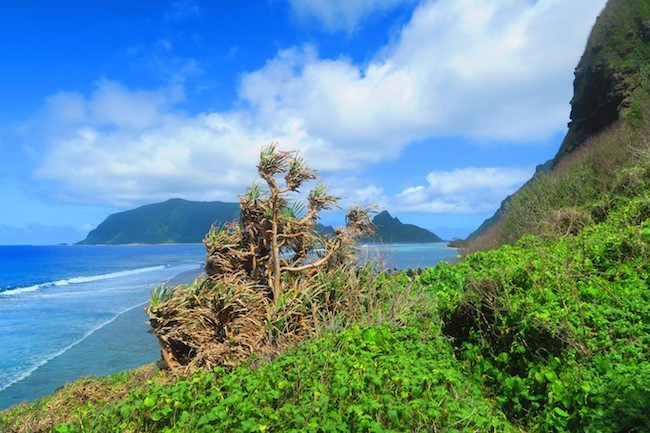
The first section of the trail is a cliff walk to the Maga Point, where you can clearly see how the curved contours of the exterior reef rapidly drop to the depths of the ocean.
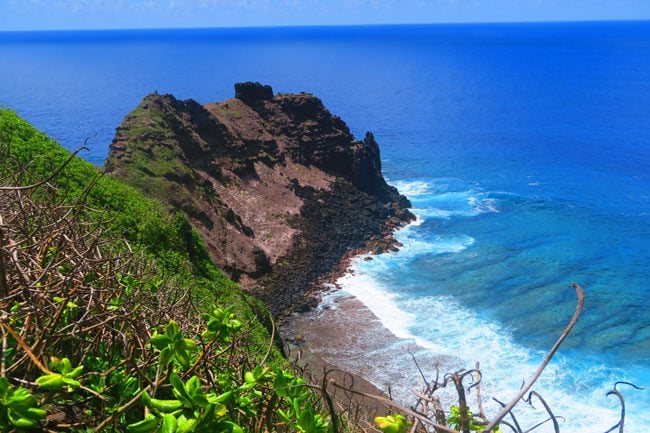
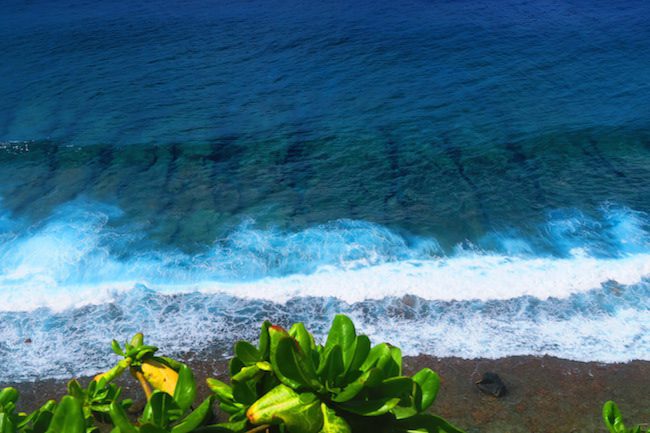
Before the trail steeply descends to the beach, stop for a quick rest and spot the boobies and frigate birds riding the thermals. Sometimes, they come down from the heavens and hover right above you. I was also lucky enough to spot a bunch of fruit bats, even though it was pretty close to noon.
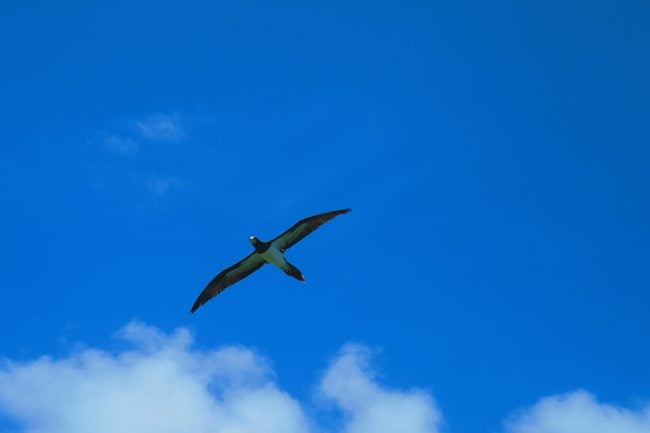
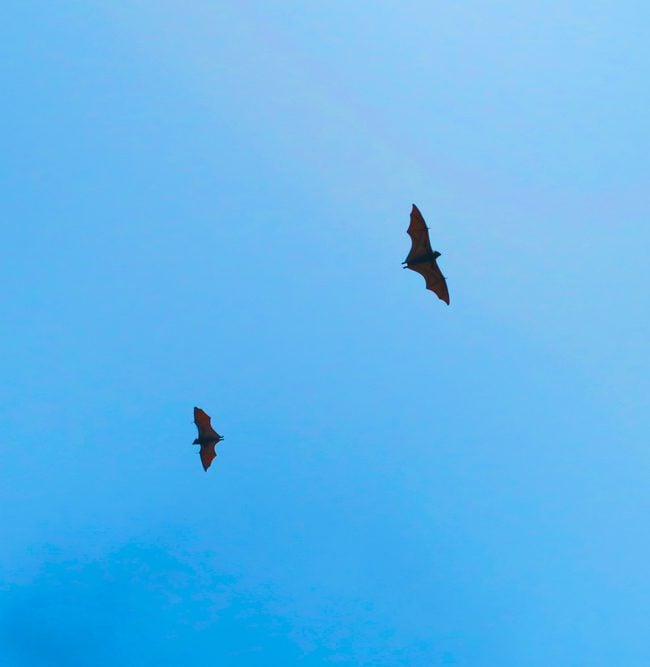
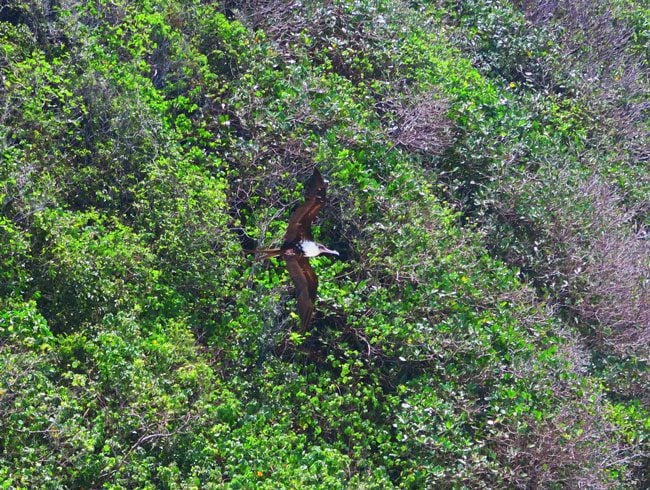
You’ll then descend to Oge Beach, a battered rocky beach that’s not safe for swimming. The beach faces Ta’u Island and somewhere in between lies one of the largest pieces of single coral in the world! There’s no shade on the beach but it’s nonetheless an inviting spot to park it for a couple of hours and just listen to the detoxing sounds of the ocean waves crashing ashore.
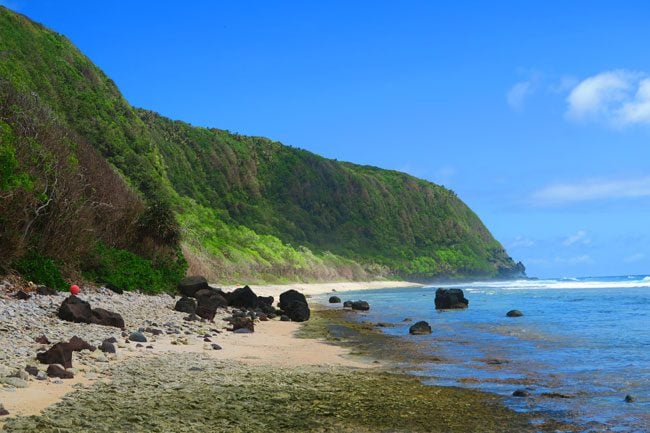
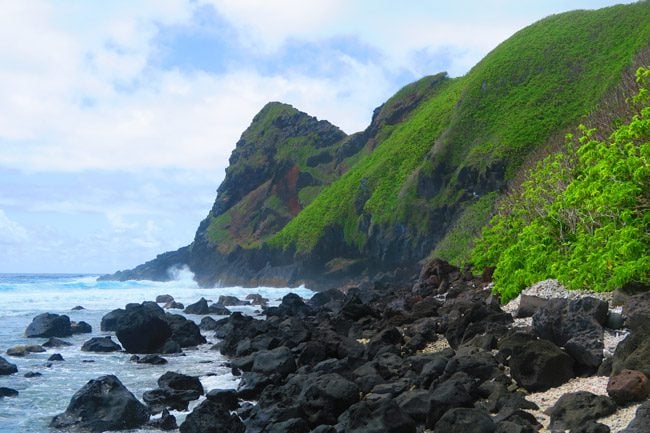
Here’s what it looks and sounds like on Oge Beach.
You’ll be completely alone on Oge Beach… well, not completely alone. I came across a bizarre scene that I was later told by a marine biologist back at the lodge has only been filmed once, so here we go.
Lurking in the shallow water are perfectly camouflaged and terrifying-looking eels. Don’t get too close as these guys actually came out onto the sand to attack me. The eels ingeniously work in small groups to attempt and catch crabs who soak in the sun on the rocks during low tide. Even when I tried to scare the shy crabs, they would not move an inch, perfectly understanding who their real predator was. This was a chilling, bizarre, and memorable ‘tropical safari’ that I’ll never forget!
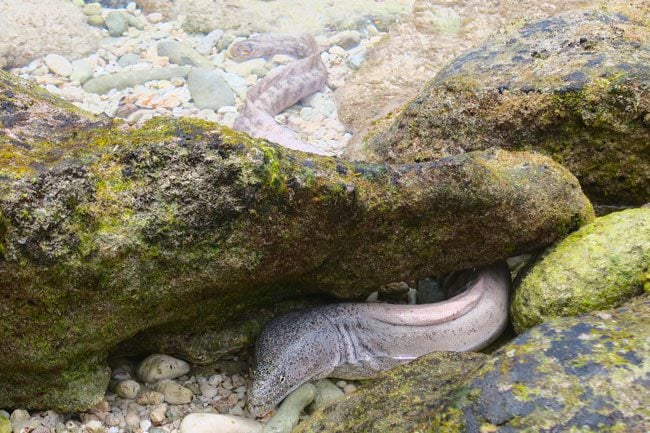
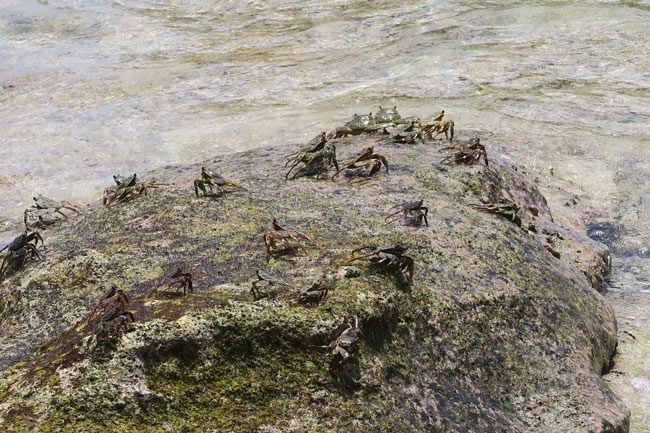
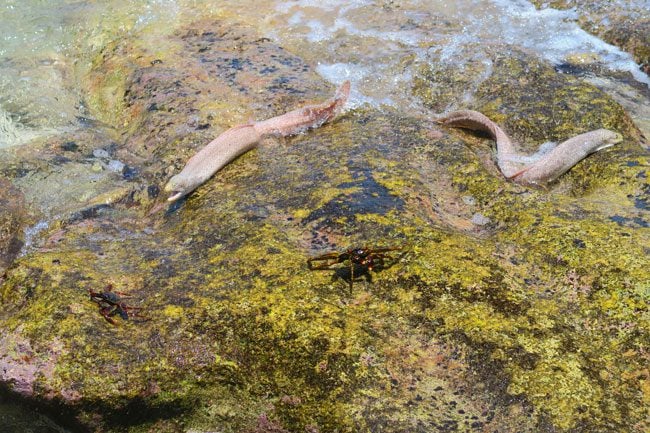
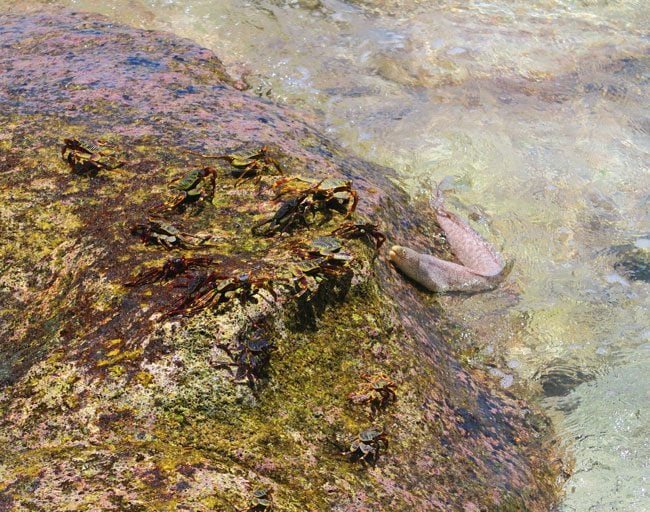
Logistics: the walk to Oge Beach takes about 1 hour from the Asaga Bridge. Bring plenty of water, snacks and don’t forget a hat and sunscreen. Wearing shorts is OK and shoes will do just fine as between the eels and the waves – you won’t really want to swim out here.
Sunsets & Stargazing
There’s no need for ESPN or HBO out here, just step out to the runway or the beach, admire the sunset and gaze at the stars. Have you ever seen the Milky Way?
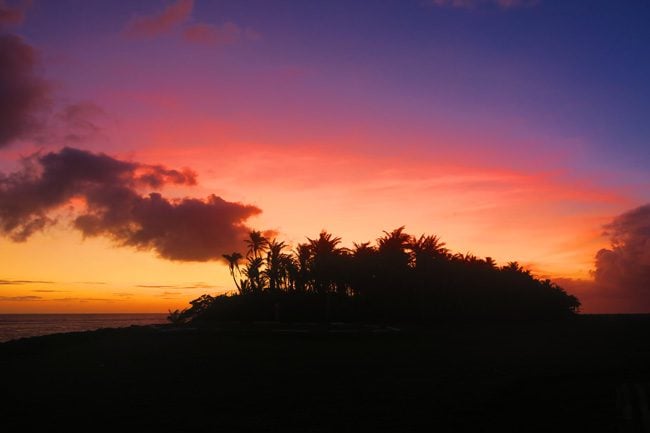
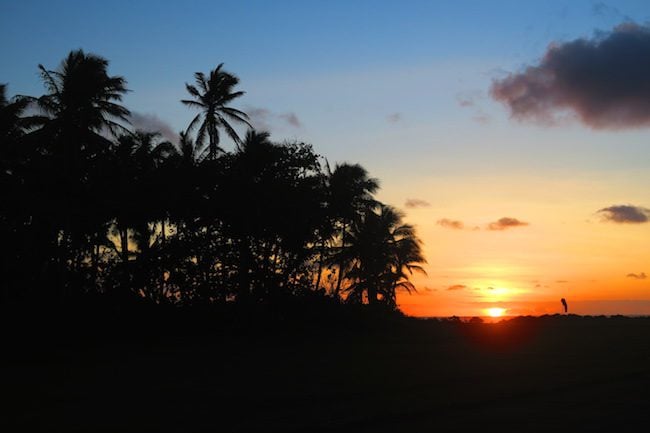
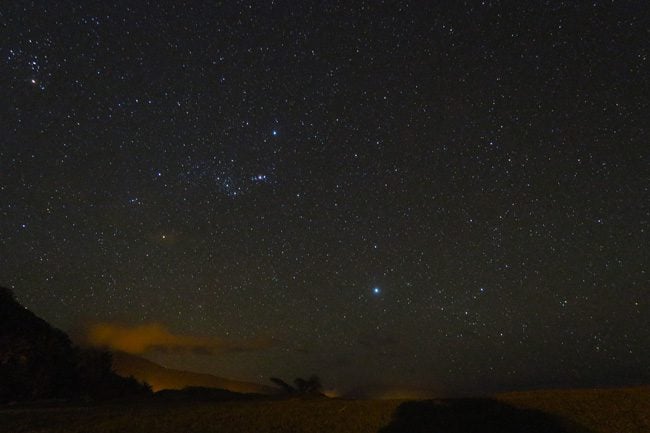
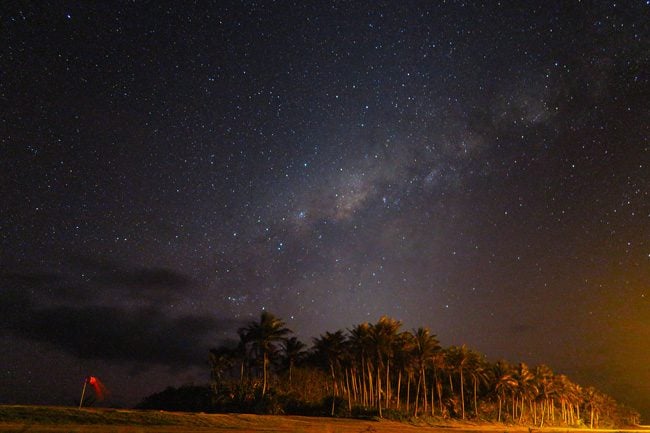
Part 3: Pago Pago (1 Day)
Your 10 days in American Samoa are coming to an end. It’ll be mighty hard to leave Ofu but you’ll feel an incredible sense of pride and gratitude for successfully making it out here.
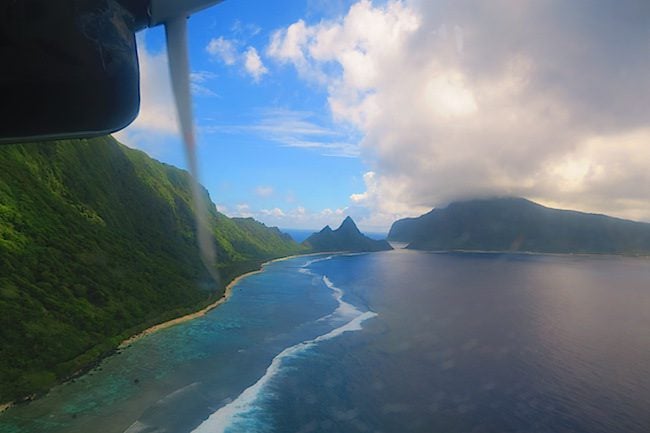
You’ll return to Pago Pago before noon and you can either rest ahead of your flight back home or rent a car and go for a spin. A recommended route to follow is west from the airport on Route 1 to the village of Leone and if you have time, all the way to Fagamalo where the road ends. Alternatively, you can drive to Pago Pago and pick up Route 6 which steeply snakes through the Rainmaker Pass down to Afono and Vatia.
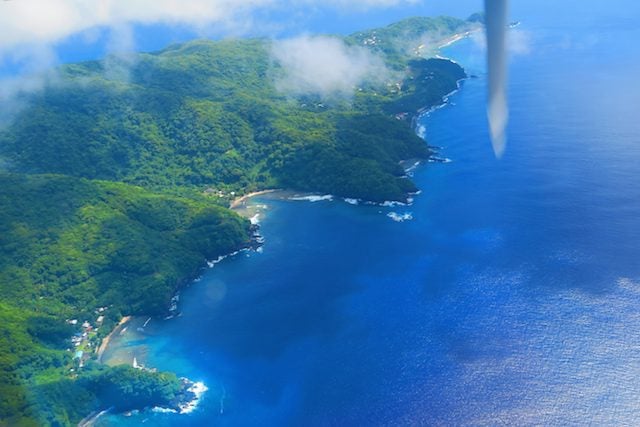
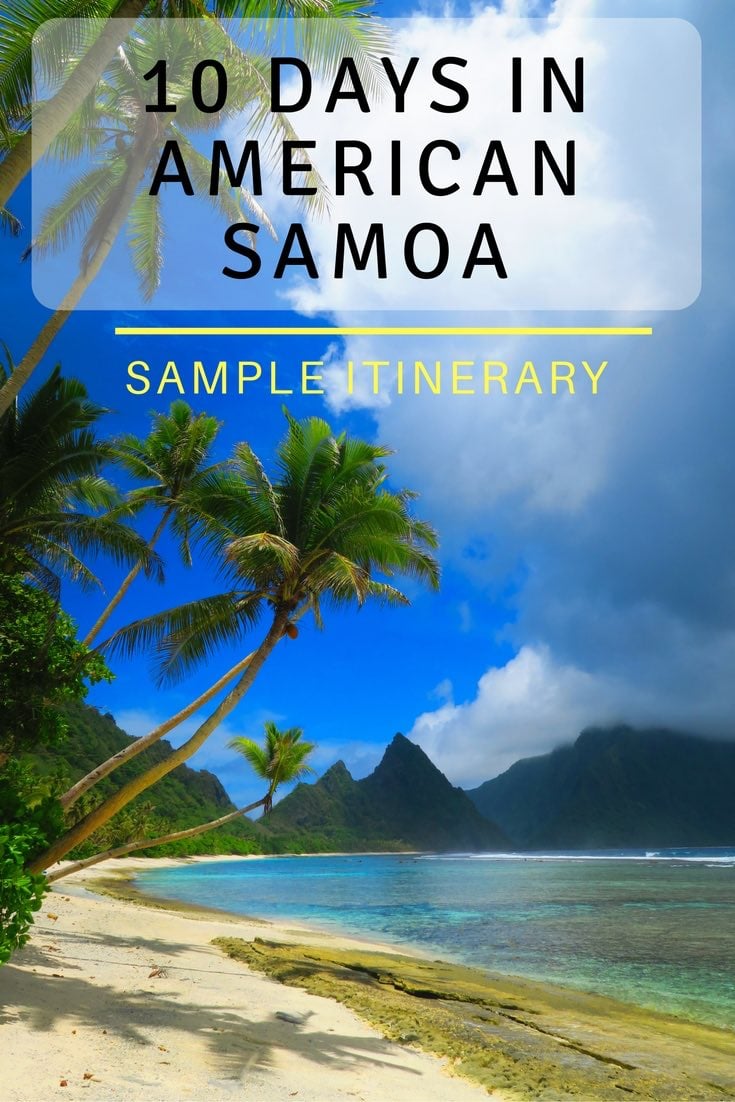
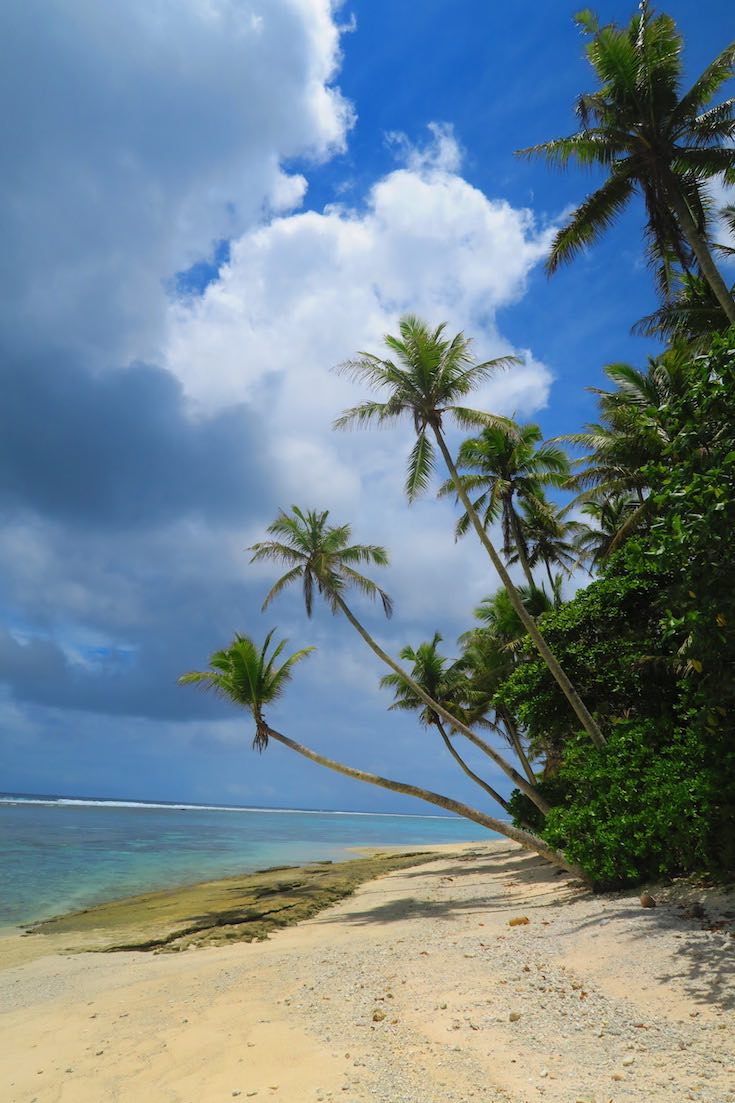
Pin These Photos To Your Favorite Boards!
